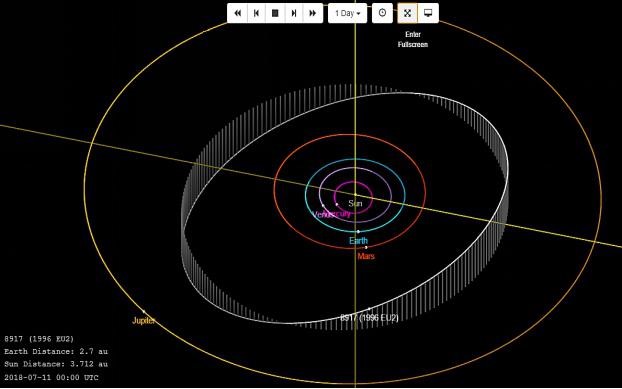Some netizens commented that "looking up at the starry sky, I can see the dream of Tianjin University, Standing on solid ground, I truly understand the 100-year old university motto- “seeking truth from facts.”
It is rare in China that an asteroid is named after a university. It is understood that asteroids are the only celestial bodies that can be nominated according to the will of the discoverers and approved by international organizations. Due to the uniqueness and permanent immutability of naming an asteroid, it is a world-recognized honor to name one. Generally, units or individuals that have made significant contributions to the national economy, society, astronomy and other undertakings can have this right.

Startrails of 11th, July 2008
According to official announcements, the asteroid was discovered on March 9, 1996 by the Beijing Schmidt Asteroid Research Program in Xinglong county,Hebei Province . It is located in the asteroid main belt between the Mars and the Jupiter in the solar system. It ranks 8917 in the asteroids of the International Astronomical Union, with an absolute brightness of 11.3 stars, a diameter of 37.122 kilometers. It is about 3.033 AU ( Astronomical Unit is a unit of length, roughly the distance from Earth to the Sun. it was defined exactly as 149597870700 metres or about 150 million kilometres (93 million miles) since 2012.) from the Earth, 3.1 AU from the perihelion, and 3.8 AU from the aphelion. Its elliptical orbital radius is about 3.4 AU. The angle between the plane of the ecliptic and the equatorial plane is 15.47 degrees, and its orbital period is 6.28 years.
The thought of naming an star after "Tianjin University " originated in 2017. To commemorate the 40th anniversary of enrollment and to promote the continuous development of the alma mater in the field of aerospace science and engineering, a group of alumni enrolled in 1977 and 1978 planned to return to their alma mater in the coming year. The idea of “sending a star” to their Alma mater was born. They spontaneously established the “Tianjin University Aerospace Science and Engineering Club (TUASEC)” and started the “Star Trek.” Finally, with the efforts of the alumni and the support of the National Astronomical Observatory, naming an asteroid after“Tianjin Da Xue”was officially announced.
As early as 1895, at the beginning of the establishment of Peiyang University, the predecessor of Tianjin University, it was integrated into the general education of students with the beauty of “Starry Sky”. According to historical records, Tianjin University (Beiyang University) is the earliest modern university in China to offer astronomy courses. In China's first university diploma (“Qinzi No.1 Appraisal”), it records basic courses of undergraduate study of Wang Chonghui,the first person learn Law in China: English, geometry, chemistry, physics, geography, astronomy, and policy to rich a country... “Astronomy” is listed among them.
TJU has never stopped its scientific exploration on the mystic universe, and has achieved fruitful results in the field of aerospace science and engineering. As early as 2008, TJU and the National Astronomical Observatory jointly established the first astronomical information technology joint laboratory in China, with supports of The School of Computer Software and the school of computer science of TJU. Based on high-performance computing, image processing, scientific data storage and processing, artificial intelligence and other technologies, it researched and explored in fields like massive astronomical observation data management and retrieval, high-performance cross-validation calculation, multi-band astronomical data fusion, astronomical observation data storage performance and energy-saving optimization, and astronomical image processing. Relevant scientific research results have been applied, such as China Virtual Observatory, real-time processing of observation data of AST3 Sky Telescope in Antarctic Kunlun Station, observation scheduling of FAST radio telescope and high-performance pretreatment of neutral hydrogen sky survey data, numerical simulation of supernova evolution, and solar activity prediction.
By: Qiu Ya
Editor: Qin Mian






